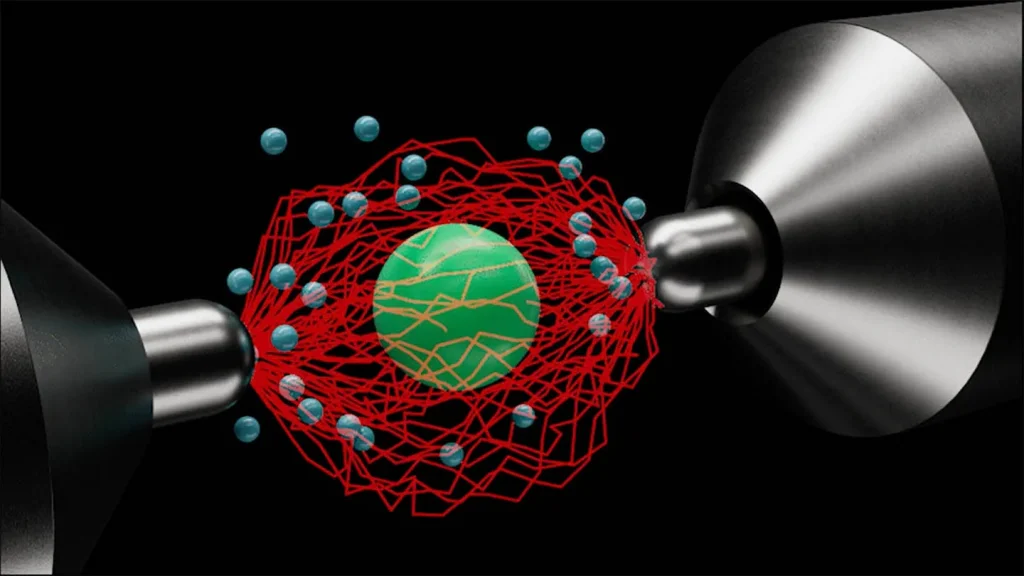A Tiny Glass Sphere at 13 Million Kelvins: Exploring the Microscopic Frontier
Scientists have achieved a remarkable feat by heating a small glass sphere to an effective temperature of 13 million kelvins—a temperature comparable to the core of the sun. This minuscule object, despite its extreme effective temperature, wasn’t actually glowing hot or melting away. Instead, researchers were measuring the sphere’s motion, finding that its atoms were vibrating with the same energy they would have if the material were truly at this astounding temperature. This breakthrough experiment opens new doors for understanding the fundamental physics that governs our world at the microscopic level, where classical physics gives way to quantum mechanics.
The experiment involved optically trapping the glass microsphere using focused laser beams, then precisely measuring its movement through space. What makes this achievement particularly significant is that the sphere exists in a curious middle ground—it’s too large to be governed purely by quantum effects (like individual atoms would be), yet small enough that its behavior differs from what we observe in everyday objects. By pushing this tiny object to such extreme effective temperatures through controlled vibration, scientists can observe how matter behaves when it contains enormous amounts of energy yet remains confined to an incredibly small space. This provides a unique window into physics at the mesoscale—the boundary between the quantum and classical worlds.
The implications of this research extend far beyond academic curiosity. Understanding how objects behave at this scale could lead to advances in ultra-precise sensing technologies, improvements in our ability to detect gravitational waves, and even help answer fundamental questions about the nature of reality. The glass sphere, vibrating with energy equivalent to temperatures found only in stellar cores, serves as a laboratory for testing theoretical predictions about how energy and matter interact at these intermediate scales. Researchers hope this work might eventually help resolve tensions between Einstein’s theory of general relativity and quantum mechanics—two foundational theories that have resisted unification for nearly a century.
What makes this achievement particularly remarkable is the technical precision required. The researchers had to isolate the glass sphere from external influences while simultaneously measuring its motion with extraordinary accuracy. Any stray air molecule, slight temperature fluctuation, or even distant vibration could disrupt the experiment. The team developed sophisticated methods to account for these challenges, creating an experimental setup that pushes the boundaries of what’s measurable. This delicate balancing act between controlling the sphere’s environment and measuring its properties represents a triumph of modern experimental physics, combining advances in optical trapping, laser technology, and precision measurement.
Beyond the technical achievement, this work highlights how physical properties we typically associate with extreme environments—like the interior of stars—can be studied in laboratory settings through creative experimental design. Rather than needing to create actual temperatures of millions of degrees, which would instantly vaporize any material, scientists can instead measure equivalent energy states in controlled systems. This approach of finding accessible analogues to study otherwise impossible conditions has been a hallmark of scientific progress, allowing researchers to make inferences about distant cosmic phenomena or subatomic processes that cannot be directly observed.
As this research progresses, it may help bridge our understanding between the weird quantum realm where particles can exist in multiple states simultaneously and the classical world of definite positions and velocities that we experience daily. The glass microsphere, jiggling with the energy equivalent of 13 million kelvins, serves as both a technological achievement and a philosophical probe. It reminds us that the boundary between different physical regimes is not sharply defined but rather a gradient where fascinating behaviors emerge. By studying these intermediate scales, scientists hope to develop a more complete and unified understanding of nature—one that encompasses both the strange quantum effects that dominate at atomic scales and the familiar classical physics that governs the macroscopic world we inhabit.


